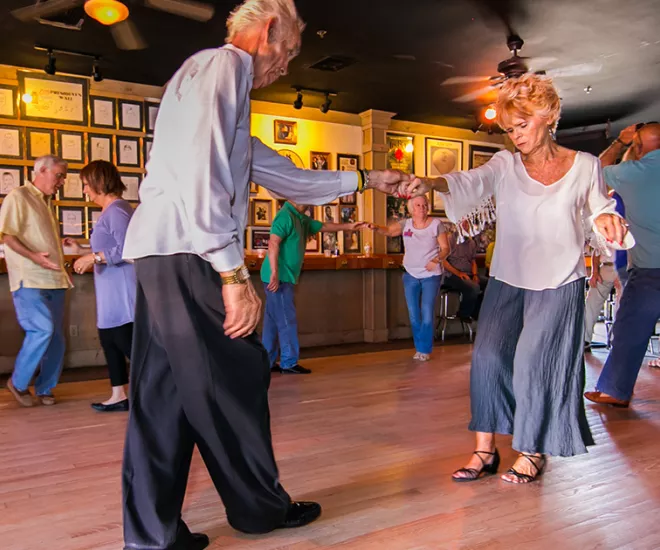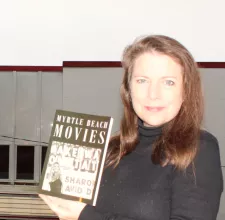Myrtle Beach in the Swing Era

A swinging good time
Before there was beach music (read about the history of beach music) or people dancing The Shag (read about South Carolina’s State Dance, The Shag,) in Myrtle Beach, there was swing.
The Swing Era reached its zenith in America in the 1930s and ‘40s but really didn’t end. The Big Band sound is still featured at many a New Year’s Eve gala or society wedding. And with the perpetual popularity of ballroom dancing--How many fans of Dancing With the Stars do you know?—the music associated with it isn’t going away any time soon.
One of the most notable dances to come out of the days of swing was the jitterbug. Done right, it was a feat of rhythm and athleticism that would have ladies spun around, lifted above their partner’s head, or even flipped over. It was truly something to behold.
If you speak with local authorities on the earliest days of the shag, you may find differing origin stories. One theory is that it evolved from the jitterbug. Shaggers along the beach didn’t mean to invent a new dance, but they just didn’t think the jerky movements of the jitterbug fit with the beach lifestyle. One veteran shagger explained that we began to dance the same way we talked to girls…nice and easy and real laid back.
The Mecca for swing music in Myrtle Beach in its heyday was The Ocean Forest Hotel. It stood up on a sand ridge overlooking the ocean with a panoramic view from 1929 until it was razed on Friday the 13th, of September 1974.
When you look at a map of Myrtle Beach, you can tell immediately where it was. Most of the city is on a grid system. Then, when you get to the area between 52nd and 62nd Avenues North along North Ocean Boulevard, in the stretch known today as the Cabana Section where those quaint little cabanas line the shore, you see on the map a hollow dot where a roundabout still is.
To make it even more conspicuous, the streets in that neighborhood form sort of a circle with two streets within its circumference that form a “V.” The roundabout is at the point of that “V.” Between that roundabout and the boulevard was where The Ocean Forest was.
The luxury hotel featured a ballroom where my parents met at a dance in the mid-1950s. But it was not the only venue there for musical performances. Outdoors on the southern lawn of the resort was the Marine Patio. It had an open-air stage and a spacious floor for dancing the night away under the stars. The big bands that played there were led by such legends as Glenn Miller and the Dorsey Brothers.
Of course, those concerts were popular and were likely to sell out. So if locals couldn’t get their hands on those tickets they had a secret alternative. Just beyond the dunes on the beach across the street, the music could still be heard. It wasn’t unusual to find couples dancing in the moonlight with their toes in the sand.
Then, when epic swing orchestras led by the extraordinary Duke Ellington, Cab Calloway, or Count Basie performed, there was another way locals could see them. Because of segregation, these African American artists could only play their gig at the Ocean Forest and then they had to leave. When they were in town, club owner Charlie Fitzgerald would invite these artists to come to Charlie’s Place afterwards for late-night jam sessions which Charlie marketed as “Saturday Night Specials.”
Today, it is a historic site at 1420 Carver Street, near the Myrtle Beach Convention Center. Back then, it was said to be the “Classiest Club on The Hill.” That was the name of this predominantly African American section of town now known as the Booker T. Washington Neighborhood.
At the Ocean Forest, there could only be white audiences, but at Charlie’s Place, everyone was welcome. There were as many White patrons there as there were Black patrons. On those nights, it was said that Carver Street was lined with Cadillacs.
Now, we call it Charlie’s Place. But if you speak to people who live in the neighborhood, they call it something else: Whispering Pines. Why? Well, there is a legend behind that name.
One night, probably in the club’s first year of 1937, because that was the one year that Billie Holiday sang with the Count Basie Orchestra, Lady Day, as she was called, gave perhaps the club’s most memorable performance. We know Count Basie played the Ocean Forest so that is when all the stars would have aligned for her to be there. The club had an outdoor patio and it’s said that when she sang out there her voice was so pure that it whispered through the pines, and the name, Whispering Pines, stuck.
There was another legendary big band, Les Brown and His Band of Renown. He traveled with Bob Hope all over the world and launched Doris Day’s singing career with their hit, Sentimental Journey. Brown and the band (Day was already a movie legend by that time) played at the Myrtle Beach Convention Center when I was a teenager. I don’t know if they ever played the Ocean Forest, but the guy who discovered Les Brown certainly did.
In 1932, a Duke University football player founded a band on campus. They were known as Nick “the Crooning Half-back” Laney and his Blue Devil Orchestra. While on a tour of the northeast that summer, Nick happened upon Les Brown playing at a YMCA and recruited him to come to Duke to take over his band when he graduated the next year.
Les had traded in high school after two semesters for the Ithaca Conservatory of Music and even spent time at the New York Military Academy. He planned to attend the University of Pennsylvania in 1932, but Duke had one of the best-known college swing bands in the country and he couldn’t pass up Nick Laney’s offer.
Brown once said that by the next year, Duke was a “red hot jazz sanctuary…The Duke Blue Devils were the rage of the campus and when Nick Laney graduated, I took over the baton.” He too toured with the band and, after his own graduation, took some of those Blue Devils and formed his Band of Renown.
In the subsequent years, while Les rose to stardom, Nick settled down in Spartanburg, South Carolina, and raised a family. He and his fiancé had eloped, had gotten married in Myrtle Beach, and had honeymooned at the Ocean Forest.
Every year they would vacation in Pawleys Island for two weeks in June. Such was the case in the summer of 1963, when their older son who was in his teens would frequent the Pawleys Island Pavilion to go shagging.
His little brother, Lanier, who was a good bit younger, would stay behind at the Ellerbe Inn with the family. But, when no one was looking, the little brother would sneak away and scurry down the road to the Pawleys Pavilion. When he’d get there, he’d find something to stand on, drag it over to one of the windows, climb up, and peer in. That was his vivid introduction to the shag.
In 1977, when he graduated from the University of South Carolina and moved to New York to start his writing career, those images were still with him. In time, he became a comedy writer for Saturday Night Live.
In 1983, fellow SNL writer Terry Sweeney, who was also a cast member, joined Lanier for six weeks at Pawleys Island’s Tip Top Inn to write a screenplay which they successfully pitched to a major motion picture studio in Hollywood. It was shot in Myrtle Beach in 1987 and released in the US in 1989. It was the most beloved movie ever made along the Grand Strand, MGM’s SHAG.
